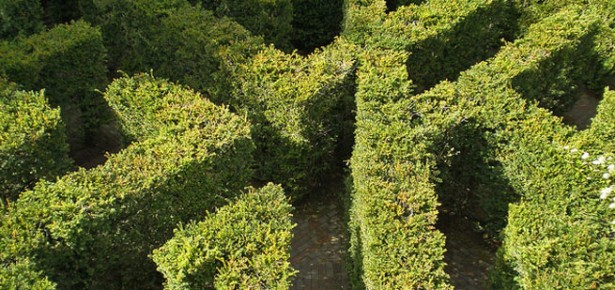
Hampton Court Maze. Photo: Amanda Slater via Creative Commons.
When I finally had the opportunity to visit England, one of the first places I visited was Hampton Court, a home of England’s monarchs since Tudor times, not only to experience a bit of its rich history but because of its incidental but nevertheless important role in the history of psychology.
One of the great insights of the first experimental psychologists was that the study of the cognitive abilities of animals could be useful both for its own sake and in comparison with those of humans. In 1899, Willard Small began the study of rats. One of the things that Small knew about rats at the outset was that they built and lived in elaborate maze-like tunnel systems. Since the rats built and lived in these tunnels it seemed to reasonable that they were able to learn how to find their way around one. So one the things that Small decided to study about rats, was how they learned a maze.
In England, the hedge maze was a traditional pastime. Hedges too tall to see over were planted in a maze pattern and people would spend their time wandering through a maze, finding their way from one end to the other. When Small decided to study the maze learning of rats, he began by building a model of the hedge maze that exists at Hampton Court from a diagram he found in the Encyclopedia Britannica. With a little encouragement from a food reward at the goal, rats were soon exploring his model and proved adept at learning it. So began one of the most productive experimental paradigms for investigating cognition ever devised.
Early in the study of animal maze-learning two different explanations for what an animal actually learned were proposed. One explanation is that if the way through the maze is to turn left then right than left again, this is what the animal learns. Since the animal learns a sequence of responses, this is called response learning.
The other explanation, championed by the creative and courageous scientist Edward Tolman, was that the animal learned a mental map of the maze and its surrounding that it followed on subsequent trips through the maze. This is called place. For response learning, an animal only needs an egocentric representation of the world in which each turn is encoded in relation to the direction it is going. For place coding, an animal needs an allocentric representation of the world in which the locations of various places in the world are encoded in relation to each other rather than any particular position of the animal.
Tolman accumulated many findings providing convincing evidence that rats engaged in place learning without ever disproving that they engaged in response. So the question of whether animals were response learnings or place learners remained unresolved until the last decade of the twentieth century, when it was finally settled by several studies, especially one in 1996 by Mark Packard and James McGaugh.
Packard and McGaugh demonstrated that the answer to the question of whether rats engaged in place learning or response learning was both. One week after training they relied on a mental map but two weeks after training they made a sequence of responses. Furthermore, Packard and McGaugh showed that place learning is controlled by one neural system in the brain that includes the hippocampus and response learning is controlled by another neural system in the brain that includes the caudate nucleus. It was only through the many decades of increasingly sophisticated research on maze learning that this basic organization of the mammalian brain was discovered.
Maze learning proved to be such an informative task to study because finding ones way around is a fundamental task that all animals perform. Consequently, there had to be throughout evolution one or more fundamental neural systems devoted to it. Furthermore, as animals evolve to meet new environmental challenges, a system devised for task may be re-purposed for another; so the neural systems originally supporting way-finding and route-following have certainly evolved to support other abilities.
For example, a representation of face is a map showing the locations and shapes of the eyes, nose, etc. So, visual recognition relies on mental maps. However, very little is known about spatial maps. So, more than 100 years after Small first placed a rat in his maze, we are only at the very beginning of our understanding of spatial representation in mammals.
So, when I went to England, I walked the Hampton Court maze to connect with all of the researchers who contributed to our understanding of cognition through maze experiments and experience the feeling of exploration and discovery of all of the rats whose participation has been essential to the enterprise.
Latest Comments
Have your say!